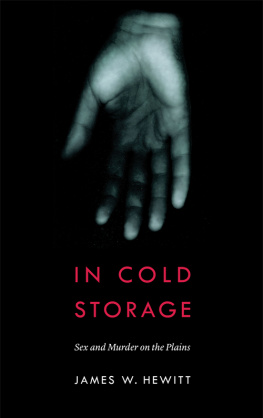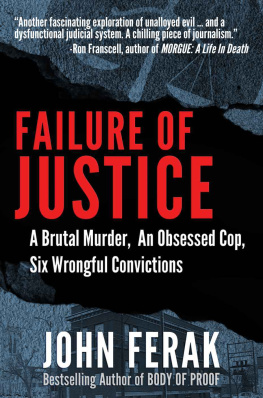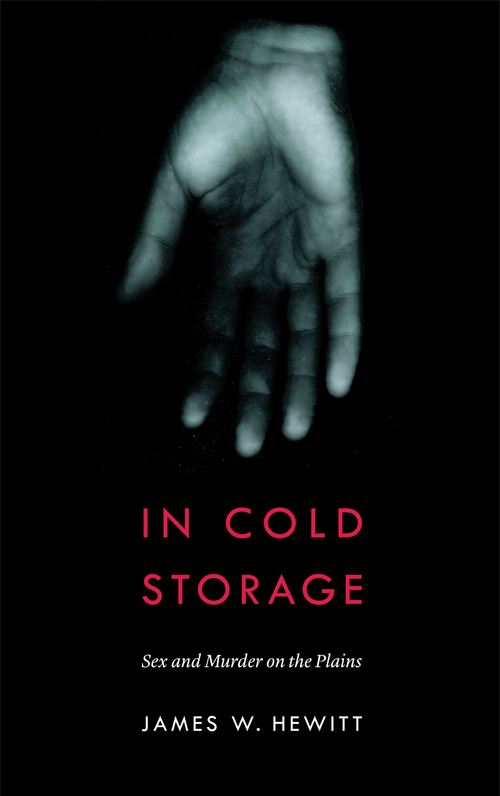James W. Hewitt
Cover design by N. Putens.
Author photo courtesy of author.
Hewitt, James W.
In cold storage: sex and murder on the Plains / James W. Hewitt.
pages cm. (Law in the American West)
ISBN 978-0-8032-5663-7 (pbk.: alk. paper)
1. Murder Nebraska McCook Case studies. 2. Murder investigation Nebraska McCook Case studies. I. Title.
HV 6534. M 385 H 49 2015
The publisher does not have any control over and does not assume any responsibility for author or third-party websites or their content.
In 1973, McCook, Nebraska, was like many other rural towns. People lived, worked, and socialized in a generally well-established routine, with infrequent disruptions. Though the people of McCook followed the daily news bulletins of the Watergate scandals, most were more interested in the high school sports team and the local farm news. There were few exceptional events in the small town.
The first signs of fall began to appear in southwestern Nebraska in September that year, as another school year was underway and there was finally some relief from the unusually warm summer. The McCook High Bisons won their first football games of the season, though no one dared dream of another 1960, when the Bisons went undefeated. Life went on as usual. October 1973, however, ushered in a season of fear and suspicion, when the town was shaken by the discovery of the murders of Edwin and Wilma Hoyt.
The Hoyts vanished from their farm home near McCook in September. They remained missing for several days, until gruesome sections of their dismembered bodies floated to the surface of an area lake. Law enforcement personnel and a private investigator worked on the case for months before finally charging McCook resident Harold Nokes and his wife, Ena, with murder. The brilliant and dogged young sheriff who was Harold Nokess jailor elicited a confession from him. Nokes pleaded guilty; his wife was never convicted of murder, based on Harolds insistence that she had no active role in the deaths. Harold was sentenced to two life sentences in the state penitentiary, where he remains some forty years later. He will never be released. The true story of why and how Harold Nokes murdered Mr. and Mrs. Hoyt remains a mystery. What he said then and what he says now regarding his actions and motive are totally different.
In 1999 I was chair of the Nebraska State Bar Associations Centennial Committee. I wanted to write an article about the Hoyt murders, a well-known and sensational case, for one of the associations publications. The court that had sentenced Harold Nokes, however, had sealed all the court records, because the files were replete with the identities of several McCook citizens who had engaged in tawdry sexual practices with one of the daughters of the Hoyts. The order sealing the files kept me from writing the article. But I decided to investigate the case further.
The prosecutor in the case, who had been a good friend since law school, turned over his personal file to me. I read it all. I learned what Harold Nokes had said during his confession in January of 1974, how and why he claimed he killed the victims, and how he disposed of the bodies.
To learn more about the case, I wanted to speak with Harold Nokes himself. After more than a year of trying to make contact with him, Nokes finally agreed to talk to me. He has never granted another interview, before or since. I spoke to him in a conference room at the state penitentiary for nearly two hours. The story he told me was so different in almost every aspect from his 1974 confession that I determined to search for the real truth.
In the course of my research, I interviewed dozens of people the law enforcement officers who were involved in the case, family members of the victims, weapons experts, and forensic psychiatrists. I traveled to southwestern Nebraska and walked the streets of McCook and the surrounding area. I read newspaper articles that discussed the case and stacks of court documents that the current district judge released to me. I wrestled with the discrepancies between Harold Nokess two stories his 1974 confession and what he told me decades later at the penitentiary finally reaching some of my own conclusions about what happened that September night.
I do not think Harold Nokes told the truth in 1974. I do not think he told me the truth when I talked to him at the penitentiary. I think his wife was much more of a participant in the killings and their aftermath than Nokes claimed. I do not think that we will ever know with certainty how and why Harold and Ena Nokes acted. But we do know that Edwin and Wilma Hoyt are dead and that Nokes admitted to killing them. I have tried to point the way, so that each reader may decide for himself or herself what really happened that September night so long ago.
I am indebted to the following persons for their valued assistance on this book: the late Paul Douglas, Judge David Urbom, Lannie Roblee, Owen and Donna Elmer, Jerry Ann Hoyt, Toney Redman, Bob Sawdon Jr., Bridget Barry, Sabrina Ehmke Sergeant, Bill Wieland, Sam Vam Pelt, Cloyd Clark, Jim and Kathryn Bellman, Rich and Joan Kopf, John Wunder, Dick Hove, Jim Cada, John Hewitt, Shawn Renner, DeWayne Hein, Ron Olberding, Jack Battershell, Jerry Smith, Kim Corgan, Win Barber, and Mrs. Pat Sexton. Their aid and encouragement sustained me over the many years that I devoted to this project.
For her unflagging attention to detail, proofreading, grammatical instruction, and the typing of draft after draft after draft, I am indebted to my wife Marjorie for the finished product and for much else. It is a debt I will never be able to repay.
Located in the remote and hilly land north and west of Cambridge, Nebraska, in the southwestern quarter of the state is Harry Strunk Lake, a mecca for Nebraska fishermen. The lake, a Bureau of Reclamation flood-control reservoir, is near the southern edge of Frontier County and is a bright spot in an otherwise lonely and rugged landscape.
On Wednesday, October 3, 1973, a strong wind pushed waves across the lake and up onto the rocks that covered the face of Medicine Creek Dam. Dean McQuiety, a farmer from near Cambridge who loved to fish, was walking along the dam that day looking for carp. As he neared the west end of the dam, he spotted something in the water. Looking closer, he saw a human foot bobbing against the rocks. Alarmed, McQuiety scanned the area. Seeing no one and nothing out of the ordinary, he bent down and gingerly pulled the foot out of the water. Leaving the disturbing find on the rocks, he hurried to the lake office of Tim Jackson, the lake supervisor, with the news of the macabre discovery. McQuiety waited nervously while Jackson telephoned the Bureau of Reclamation office in McCook, twenty-five miles to the southwest, and the Frontier County Sheriffs Office in Curtis, some thirty miles to the north, advising them both of the discovery.















